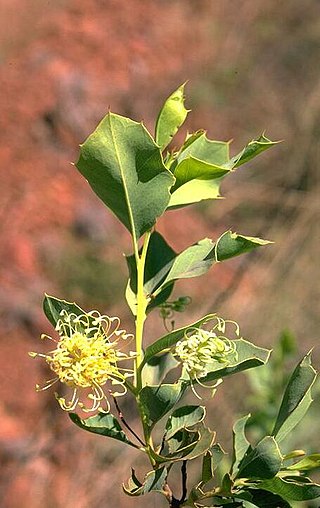
Grevillea thelemanniana, commonly known as spider net grevillea, is species of flowering plant in the family Proteaceae and is endemic to Perth, Western Australia. It is a spreading shrub with linear and pinnatipartite to pinnatisect leaves with linear to narrowly elliptic lobes, and clusters of 6 to 14 pinkish-red and cream-coloured flowers with a red, green-tipped style.

Grevillea intricata is a species of flowering plant in the family Proteaceae and is endemic to the west of Western Australia. It is a densely-branched shrub with tangled branchlets, divided leaves with linear lobes and clusters of pale greenish-white to light cream-coloured flowers.

Grevillea tripartita is species of flowering plant in the family Proteaceae and is endemic to the south-west of Western Australia. It is an erect, prickly shrub with divided leaves with 3 lobes, and clusters of red and cream-coloured or reddish-orange and yellow flowers.

Grevillea parallela, also known as silver oak, beefwood or white grevillea, is a species of flowering plant in the family Proteaceae and is endemic to northern Australia. It is a single-stemmed shrub or small tree with pinnatisect or pinnatipartite leaves, the lobes linear to strap-like, and cylindrical clusters of white to cream-coloured or pale yellowish-green flowers.

Grevillea evanescens is a species of flowering plant in the family Proteaceae and is endemic to the south-west of Western Australia. It is an erect to spreading shrub with oblong to elliptic leaves and clusters of pale to bright red and cream-coloured flowers.
Grevillea glabrescens is a species of flowering plant in the family Proteaceae and is endemic to the Northern Territory. It is an open, erect shrub with oblong leaves that have triangular teeth or lobes on the edges, and clusters of white to cream-coloured or very pale yellow flowers.
Grevillea lullfitzii is a species of flowering plant in the family Proteaceae and is endemic to a relatively small area of inland Western Australia. It is a spreading shrub with deeply divided leaves, the lobes linear and sharply-pointed, and clusters of greyish-white and cream flowers with an off-white style.
Grevillea lissopleura is a species of flowering plant in the family Proteaceae and is endemic to a relatively small area of inland Western Australia. It is an erect shrub with linear leaves and clusters of white to cream-coloured flowers.
Grevillea nematophylla, commonly known as water bush or silver-leaved water bush, is a species of flowering plant in the family Proteaceae and is endemic to Australia. It is shrub or small tree with simple or pinnatisect leaves, the leaves or lobes linear, and branched, cylindrical clusters of cream-coloured flowers.

Grevillea mimosoides, commonly known as caustic bush, is a species of flowering plant in the family Proteaceae and is endemic to northern Australia. It is a shrub or small tree with curved, narrowly elliptic or egg-shaped leaves and greenish-white to cream-coloured or pale yellow flowers.

Grevillea erythroclada, commonly called needle-leaf grevillea, is a species of flowering plant in the family Proteaceae and is endemic to northern Australia. It is a shrub or small tree with divided leaves, the ultimate lobes linear to more or less cylindrical, and clusters of cream-coloured to pale yellow flowers.

Grevillea monticola is a species of flowering plant in the family Proteaceae and is endemic to the south-west of Western Australia. It is a spreading to erect shrub with toothed to pinnatifid leaves with sometimes branched clusters of pale cream-coloured to yellowish-cream flowers.
Grevillea murex is a species of flowering plant in the family Proteaceae and is endemic to a relatively small area of south-western Western Australia. It is a spreading, much-branched shrub with hand-shaped leaves and clusters of greenish-white to dull cream-coloured flowers.

Grevillea prasina is a species of flowering plant in the family Proteaceae and is endemic to north-western Australia. It is a spreading or straggly shrub with egg-shaped to elliptic leaves with coarsely-toothed edges, and dense, cream-coloured to pale yellow flowers, the style pale green to white.

Grevillea psilantha is a species of flowering plant in the family Proteaceae and is endemic to a small area in the Kimberley region of Western Australia. It is an erect shrub with erect, linear to narrowly egg-shaped leaves, and cylindrical clusters of white to cream-coloured flowers.

Grevillea pyramidalis, commonly known as the caustic bush, is a species of flowering plant in the family Proteaceae and is endemic to north-western Australia. It is an erect, spindly shrub or small tree with simple linear or pinnatisect leaves with linear to narrowly egg-shaped lobes, and white to yellow or cream-coloured flowers.
Grevillea rogersoniana, commonly known as Rogerson's grevillea, is a species of flowering plant in the family Proteaceae and is endemic to a restricted area near Shark Bay in Western Australia. It is an erect shrub with spatula-shaped leaves with 3 to 5 teeth or shallow lobes on the end, and cylindrical clusters of reddish pink flowers, the style with a cream-coloured tip.

Grevillea trifida is species of flowering plant in the family Proteaceae and is endemic to the southwest of Western Australia. It is a spiny, erect to low spreading shrub, usually with divided, variably-shaped leaves, and clusters of white to cream-coloured flowers.

Grevillea velutinella is species of flowering plant in the family Proteaceae and is endemic to northern Western Australia. It is a shrub with broadly egg-shaped leaves in outline, sometimes with 2 to 7 teeth, and down-turned, often branched clusters of yellowish-green to lemon or cream-coloured flowers.
Grevillea saxicola is a species of flowering plant in the family Proteaceae and is endemic to the Pilbara region of Western Australia. It is a shrub or small tree usually with pinnatisect leaves with linear lobes, and cylindrical clusters of cream-coloured to pale yellow flowers.













